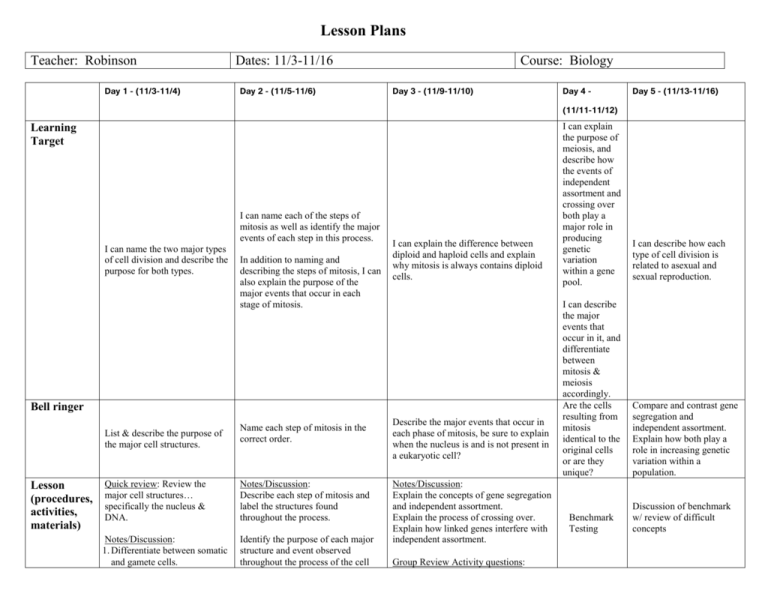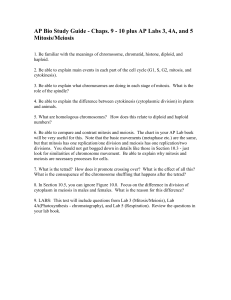Lesson Plans Teacher: Robinson Dates: 11/3
advertisement

Lesson Plans Teacher: Robinson Day 1 - (11/3-11/4) Dates: 11/3-11/16 Day 2 - (11/5-11/6) Course: Biology Day 3 - (11/9-11/10) Day 4 - Day 5 - (11/13-11/16) (11/11-11/12) Learning Target I can name each of the steps of mitosis as well as identify the major events of each step in this process. I can name the two major types of cell division and describe the purpose for both types. In addition to naming and describing the steps of mitosis, I can also explain the purpose of the major events that occur in each stage of mitosis. I can explain the difference between diploid and haploid cells and explain why mitosis is always contains diploid cells. Bell ringer List & describe the purpose of the major cell structures. Lesson (procedures, activities, materials) Name each step of mitosis in the correct order. Quick review: Review the major cell structures… specifically the nucleus & DNA. Notes/Discussion: Describe each step of mitosis and label the structures found throughout the process. Notes/Discussion: 1. Differentiate between somatic and gamete cells. Identify the purpose of each major structure and event observed throughout the process of the cell Describe the major events that occur in each phase of mitosis, be sure to explain when the nucleus is and is not present in a eukaryotic cell? Notes/Discussion: Explain the concepts of gene segregation and independent assortment. Explain the process of crossing over. Explain how linked genes interfere with independent assortment. Group Review Activity questions: I can explain the purpose of meiosis, and describe how the events of independent assortment and crossing over both play a major role in producing genetic variation within a gene pool. I can describe the major events that occur in it, and differentiate between mitosis & meiosis accordingly. Are the cells resulting from mitosis identical to the original cells or are they unique? Benchmark Testing I can describe how each type of cell division is related to asexual and sexual reproduction. Compare and contrast gene segregation and independent assortment. Explain how both play a role in increasing genetic variation within a population. Discussion of benchmark w/ review of difficult concepts 2. Describe the different forms DNA can take… including nucleoid, chromatin, chromatids, chromosomes, & homologous chromosomes. 3. Describe the cell cycle including a summary of the major events that occur during interphase (G1, S, and G2) as well as the general overall purpose of mitosis/cytokinesis. 4. Review some illustrations of the cell cycle. Wrap up / Exit ticket Homework Assessments Differentiate between the purpose of mitosis and meiosis. How does an organisms’ asexual/sexual mode of reproduction influence the type of cell division an organism uses? Workbook, p. 193-196 (due) 206-212 assigned Questions from lecture/discussion cycle/mitosis. 1. Review bell ringers & exit slips. 2. Summarize the major events of the cell Explain how this process is different cycle between plants and animals 3. Justify how mitosis is used for growth (concerning the cell plate formation (identical cells) and meiosis is for in plant, but a cell membrane variation. cleavage in animal cells). 4. Differentiate between haploid and diploid cells. Review somatic and gamete cells 5. Differentiate between somatic and concepts. gamete cells. 6. Do all organisms that undergo mitosis Describe the major differences also experience meiosis? between diploid and haploid cells. 7. Do all organisms that experience Explain the purpose for this. meiosis also undergo mitosis? What is the difference between a diploid cell and a haploid cell? Draw an example of a cell that has 6 chromosomes in metaphase would What are the major differences of appear like. Is the nucleus present? mitosis and meiosis? Include a Why or why not? description that identifies not just the difference in purpose, but also in chromosomal layout. Workbook, p. 206-212 (due) Review for test Homework & discussions Organize a review sheet from the bell ringers & exit tickets for this unit. Competency/Objective: Obj 4b. Differentiate between the types of cellular reproduction. How do the major events of meiosis produce cells that are they unique (assorted) when compared to the parents? Corrections test Class discussion








